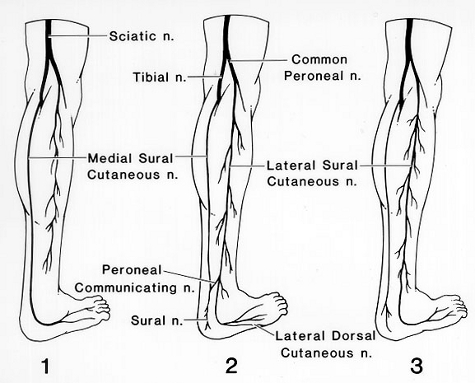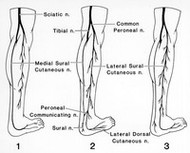Leg Numbness During Meditation
Posted by Jay Suthers on May 23rd, 2014
I talk to many customers throughout the week. They generally have questions about the products or want to work with a "real person" to place an order. I enjoy that aspect of my work here at Sage Meditation even though it can take a lot of work. I meet so many wonderful people.
One topic we frequently discuss is "Why do my legs fall asleep during meditation?" or, more importantly "How do I prevent my legs from falling asleep during meditation?"
The answer to the first question lies in the anatomy of the legs. As you well know, our bodies are filled will bundles of nerves and blood vessels each serving a vital function in the tissues of our bodies. Unfortunately, these components are not always well placed and such is the problem with the nerves that causes leg numbness. Looking at the illustration below, you will see that there are a few key nerve channels that run down the back and outside of each leg. Most problematic for cross-legged meditation is the Peroneal nerve channel that is in the tissue next to the Tibia and Fibula bones of the lower leg. The numbness that you experience is cause by pressure on this area that essentially pinches the Peroneal nerve to one degree or another. This pinch can partially or fully block the flow of the chemical potassium inside the nerve channel.

When the nerve becomes compressed and the flow of potassium stops, the nerve stops conducting. The result is a whole host of nerve miscommunication to the brain, which creates this intense numbing feeling. When the pressure is removed and the potassium begins to flow, the nerves wake up and begin to fire abnormally. Anyone who has experienced leg numbness will tell you that the tingling sensation while recovering from it seems more intensely uncomfortable than the numbness itself.
In answering the second question, preventing the legs from becoming numb falls into a few categories, 1) cushioning, 2) posture, 3) shifting position, and 4) discovery. Unfortunately, the nerves are there and, if you sit in a way that puts pressure on them you will likely experience the numbness. Fortunately, every aspect of meditation is a journey - including finding the best posture for you that will minimize or eliminate leg numbness.
Cushioning
Of course, this is the business of Sage Meditation. We offer several sitting cushions and a discounted price on our Zafu and Zabuton Meditation Cushions and Cosmic Cushion and Zabuton Meditation Cushion Sets. The Zabuton is a flat cushion with cotton batting designed specifically to reduce the pressure on the lower legs during sitting meditation. Believe it or not, even a carpeted floor is insufficient padding for meditation. A folded blanket is a little too dense to provide much relief. And, a hardwood or tile floor will surely cause discomfort during sitting meditation. Cushioning is important. In the illustration above, the Sciatic nerve, which goes up in the buttocks area, is also susceptible to being compressed and causing numbness in the legs and buttocks. So, a good Zafu or other cushion is also essential.
Posture
Many people meditate while seated on the floor. This is how we envision the Buddha and other Gurus and Saints when we think of meditation. Who ever saw a statue of the Buddha in a chair? But, as we get older and, for many men, less flexible, floor sitting creates greater problems with leg numbness and other discomfort during meditation. Since the goal of meditation is in the mind, we may simply have to accept that our bodies need us to be more comfortable whether its in a chair, on a meditation bench, or in a lying pose on a comfortable cotton mat.
Shifting Posture
Some meditation practices discourage any movement during meditation. This can be a great discipline. Yet, I find that if I experience numbness in the legs or buttocks during meditation, a slight shift in posture can alleviate the point of pressure that is causing the numbness. A slight shift in the position of the foot might do it, but in some cases I may need to extend the leg completely or place my foot on the outside of my body instead of folded in. If I do this in a gentle and loving manner, I can create greater comfort without disturbing my meditative state - far more so than I can by wrestling with the numbness.
Discovery
I'll repeat my earlier point - meditation is a journey. That journey includes the discovery of the mind and discovery of the body during meditation. I consider the process of finding my best posture, getting the right cushions with the right lift, and achieving the best comfort during meditation all a part of the journey. Discovering what works best for you in meditation will help you to have better and different experiences during meditation. As time goes by and we change physically, mentally, and spiritually, our meditation journey will change as well.
Thank you for reading,
Jay
If you would like to comment on this blog or have any questions, please feel free to Contact Sage Meditation Customer Service.

